My name is Yves Lalune. I live in France. I have been working for Knowledge Capital as an intern for five months and I am now a reporter for the Knowledge World Network.
It is an honor for me to present you my country through the Knowledge Capital website. For my first article, I would like to introduce you my hometown, called Dijon.
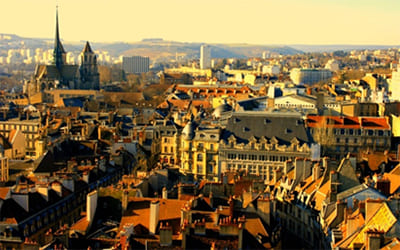 Dijon
DijonDijon is the capital of Burgundy, the city of the Dukes of Burgundy, and is renowned for its gastronomy: Its wine, mustard, ginger bread and “crème de cassis” (a liqueur) are known worldwide. I live near the “Place de la République”, one of the main squares of the city. It was renewed a few years ago in order to welcome our new tramway. The tramway of Dijon was inaugurated in 2012 and was promoted as a more environmental friendly and quiet means of transportation. By promoting this kind of means of transportation, the aim of the mayor of Dijon (Mr. François Rebsamen) is to make Dijon the first ecological city of France. In order to achieve this goal, several places in Dijon were modified not only for the good functioning of the tramway, but also to reduce the traffic of polluting vehicles in the city. This is the case for the Place de la République, as mentioned earlier, but also for the most crowded street of the city, Rue de la Liberté (Street of the Liberty).
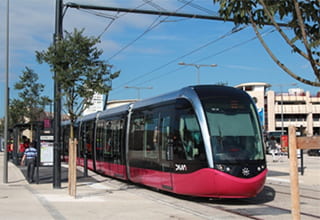
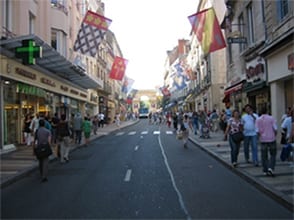
- Rue de la Liberté, before the reconstruction work
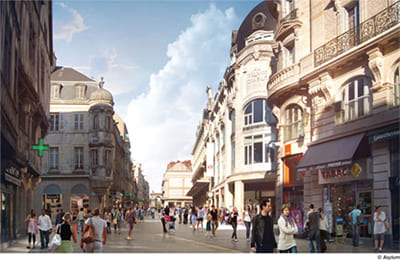 Rue de la Liberté, after the reconstruction work. The area became an entirely pedestrian zone.
Rue de la Liberté, after the reconstruction work. The area became an entirely pedestrian zone.Near the town center, you will most likely pass through the old district of the city and see this kind of old houses:
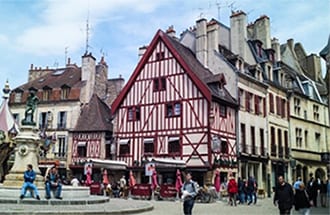
- Half-Timbered House, Place du Bareuzai
Those houses, built during the 15th century, called “Maisons à colombages” or “Half-timbered houses”, represent a very distinctive architectural style of the city. Aren’t they charming? It my opinion, they give a unique vibe to the city. Despite the fact that the architectural style has been preserved through the centuries, those houses are renewed regularly for safety reasons.Next to the old district, there is the church Notre Dame de Dijon. This 13th century church is known for its gargoyles and for the Owl of Dijon, the most famous of the numerous symbols of the city. It is said that if you put your index finger in the hole just below the Owl of Dijon, it will make your wishes come true. Be careful though, the little dragon carved next to the owl will eat your wish if you walk in front of it.
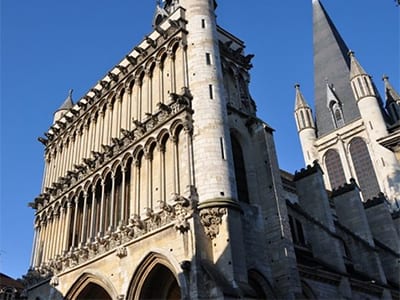
- Notre-Dame de Dijon, outdoors
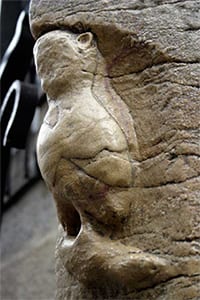
Before going towards the main plaza of Dijon, I suggest you stop by the Museum of Arts. The access is free, and you will get a chance to see the tombs of two of the Dukes of Burgundy. The Duchy of Burgundy is of a great importance in the history of France. From the 9th century to the 15th century, the power of the Dukes of Burgundy rivaled even the power of the king of France himself. Burgundy was one of the richest regions of France. It was so wealthy and powerful that it even expanded to the Netherlands at some point. In the museum, you can see the tombs of Philippe Le Hardi (literally “The Brave Philippe”), first Duke of Burgundy, and the tombs of his son Jean Sans Peur (literally “Jean the Fearless”) and Marguerite De Bavière, wife of Jean Sans Peur.Under the tombs can be seen 74 alabaster little statues of priests, monks and knights crying in sadness. These statues are called the Mourners of Dijon, and were sculpted in order to show the grief and sorrow of the people when the dukes died. This work of art is known worldwide and has even been displayed at the New York’s Metropolitan Museum.
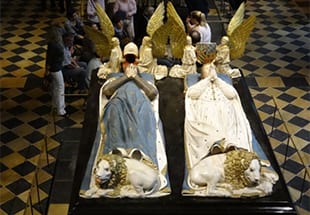
- Jean Sans Peur and Marguerite de Bavière
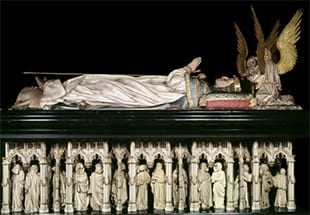
- Philippe le Hardi (and his Mourners)
As you can tell from this short presentation, Dijon is a city with a strong historical and cultural background. But even though there is a clear will from the inhabitants of preserving the cultural treasures of the city, Dijon is also a city looking towards the future. Just like Japanese people, we inhabitants of Dijon are constantly living between the past and the future, on the edge of traditions and modernity.



 Rue de la Liberté, after the reconstruction work. The area became an entirely pedestrian zone.Near the town center, you will most likely pass through the old district of the city and see this kind of old houses:
Rue de la Liberté, after the reconstruction work. The area became an entirely pedestrian zone.Near the town center, you will most likely pass through the old district of the city and see this kind of old houses:
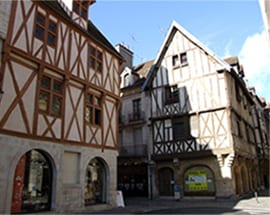




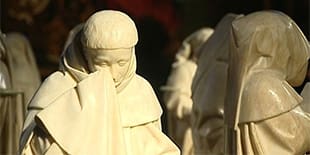
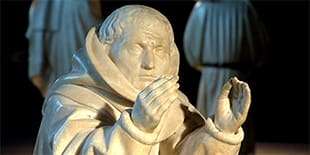




 Rue de la Liberté, after the reconstruction work. The area became an entirely pedestrian zone.Near the town center, you will most likely pass through the old district of the city and see this kind of old houses:
Rue de la Liberté, after the reconstruction work. The area became an entirely pedestrian zone.Near the town center, you will most likely pass through the old district of the city and see this kind of old houses:






























































